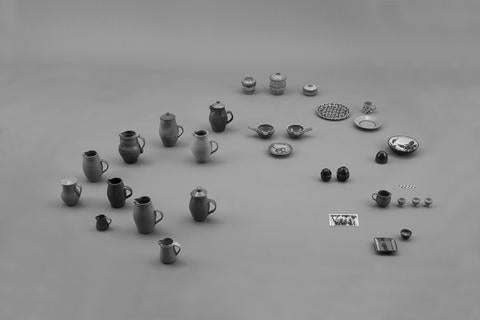
Gemma Holt and Max Lamb ceramic collection, installtion shot from ‘design is a state of mind’, Serpentine Gallery, Photo courtesy of Angus Mill
Sometimes it takes traveling to the other side of the world to learn about what’s closest to home. Living and working in J.B. Blunk’s house in Inverness, California, using the kiln and clay he left behind, my partner, Max Lamb, and I were given the opportunity to study the craft of pottery for the first time.
Blunk himself had been led to pottery after attending an inspirational lecture by the famed British potter, Bernard Leach, in California in 1951. Following his discharge from the Korean War, Blunk went to Japan in search of the master craftsmen he had learned so much about in his ceramic classes at UCLA. There, he was introduced, via a chance meeting with Isamu Noguchi, to the great Japanese stoneware tradition, and was subsequently mentored by Japanese National Treasures Kitaoji Rosanjin and Toyo Kaneshige. This was to become the start of an interwoven history in which Blunk’s meeting with Noguchi lead him to a beautiful plot of land perched in the hills of the Point Reyes National Seashore. Amongst the Bishop Pines that mantle the hillside, he built the wooden house he called home for the next 50 years, and in which we were lucky enough to live for a few months back in 2009.
Having passed away in 2002, the master no longer occupied the Inverness house and studio, but through the legacy of his hand-built home and the furniture and ceramics therein, we learned how to make and appreciate objects in his tradition. Armed with a copy of A Potter’s Book, written by Leach in 1940 and believed by many to be the definitive book for potters, we set to work – quickly realizing that pottery isn’t something you can just dabble in. Rather, it is an art and a science, one you must dedicate your life to in order be able to produce beautiful, functional objects. So, we stuck to collecting it instead.
Back home in England, we quickly became obsessed with researching and collecting British studio pottery. Most of our collection is based on the output of The Leach Pottery, founded in 1920 in St. Ives, England, and the pottery’s many apprentices. Bernard Leach’s apprenticeship system was also one of chance meetings and mentorship, and became the foundation for many of Britain’s most revered potters. The pottery’s Standard Ware collection was meant to serve as affordable, everyday tableware “produced” by Leach’s apprentices. Even though each piece was made by a different potter, each potter followed the same regimented process to achieve Leach’s exacting designs. But as the pieces are also made by hand, and by many different hands, each one remains unique.
Many of Leach’s apprentices, including his own sons and grandsons, went on to start their own potteries, working in the same tradition. The individual yet collective nature of their output is what kept us hooked. The pieces we collect aren’t locked away in cabinets but used and celebrated every day – no one piece holds more value to us than another. Pottery comes to life when sat on the dining table laden with food, surrounded by friends. Our collection has become, like the rest of our lives, about relationships and chance meetings.
